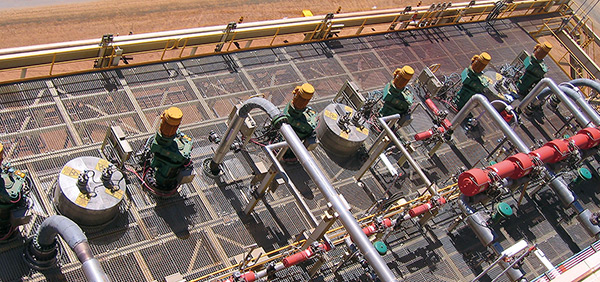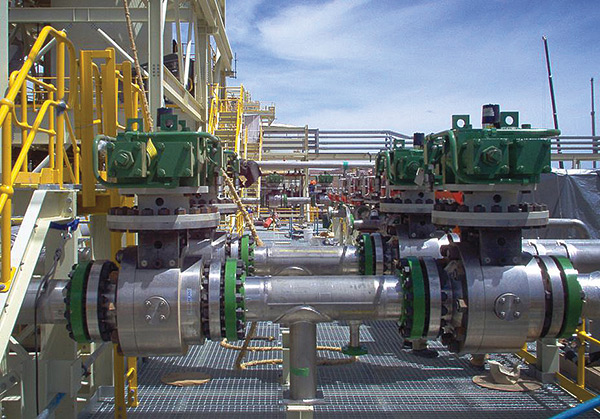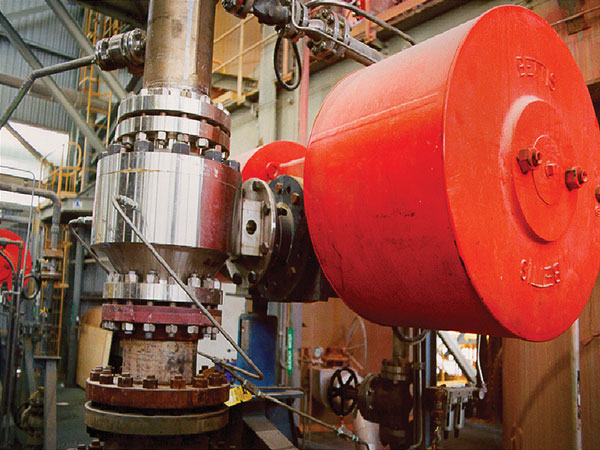- Home
- Industries
- Metals & Minerals
- Autoclave
Autoclave
Severe service valves for HPAL and POx autoclave applications in the mining industry
 Many of MOGAS design advancements are the direct result of creating application-specific solutions to address the demanding conditions of autoclave processes.
Many of MOGAS design advancements are the direct result of creating application-specific solutions to address the demanding conditions of autoclave processes.
High pressure acid leaching (HPAL) and pressure oxidation (POx) are two of the most demanding extraction methods in the mining industry and require dependable, time-tested severe service valves and coatings. Whether leaching with acid injection or oxygen, the valves used in these plants must withstand corrosive and abrasive slurries, as well as endure punishing temperatures and pressures.
For several decades, MOGAS has been the leading provider of severe service metal-seated ball valves in autoclave applications such as HPAL and POx. In fact, the majority of all autoclaves worldwide use MOGAS severe service ball valves. Reliable valve operation is crucial, since these plants are often located close to the ore beds—making travel challenging, should service be required. Harsh media and tough operating conditions make a proven, application-specific valve design essential to the economic performance of the operation.
The majority of all autoclaves worldwide use MOGAS valves.
-
 Multiple MOGAS valves were chosen to handle the punishing discharge system, one of the toughest applications in the HPAL operation.
Multiple MOGAS valves were chosen to handle the punishing discharge system, one of the toughest applications in the HPAL operation.
Valves for High Pressure Acid Leaching (HPAL)
High Pressure Acid Leaching (HPAL) was developed to extract mineral from concentrate nickel laterite ores by injecting an acid lixiviant and high pressure steam into slurry feed in an autoclave vessel. The high operating pressures and temperatures, combined with the acidic slurry, create a highly corrosive and erosive environment. These conditions can deteriorate the integrity and sealing abilities of inferior valves used in these applications.
MOGAS application-specific valve designs, material selections, and proprietary coatings have been proven effective for autoclave processes. Displaying twice the wear resistance and significantly greater fracture toughness than others, our proprietary coatings are verified to be resistant to corrosion in both autoclave vapor and slurry environments.
- HP Heater Vessel Drain
- HP Heater Isolation
- Slurry Pump Suction Isolation
- Slurry Feed Pump Isolation – Secondary
- Slurry Feed Pump Isolation – Primary
- Slurry Feed Pump Discharge Drain
- Steam Isolation – Secondary
- Steam Isolation – Primary
- Discharge Isolation – Primary
- Discharge Isolation – Secondary
- Discharge Line Drain
- Vent Isolation – Primary
- Vent Isolation – Secondary
- High Pressure Choke Water Fill
- Heater Pressure Control
- Heater Feed Isolation
- Steam Supply Control
- Flash Vessel Drain
- Acid Feed Isolation – Secondary
- Acid Feed Isolation – Primary
- Acid Line Drain
- Slurry Feed Pump Suction Drain
- HP Air Isolation – Primary
- HP Air Isolation – Secondary
- Steam Supply Drain
- Vent Isolation Drain
-
 MOGAS 10-inch 300 Class discharge valve for POx application has been designed with purge ports.
MOGAS 10-inch 300 Class discharge valve for POx application has been designed with purge ports.
Valves for Pressure Oxidation (POx)
The Pressure Oxidized (POx) autoclave circuit is a hydrometallurgical process that recovers minerals from sulphide ores by injecting oxygen into slurry in an autoclave vessel. Operating at high pressures and temperatures, the exothermic POx process generates heat and acid. This creates an oxygen rich environment where components require exotic materials, such as super duplex and Ti-niobium, to prevent flash ignition.
From field analysis, MOGAS has learned that the importance of material selection can also affect the geometry of a valve during thermal expansion—potentially jeopardizing its sealing integrity. Exotic materials, coating types and application methods require extensive knowledge of metallurgical properties and a full understanding of the POx process when oxidizing metals such as gold, copper or uranium.
Building on years of global experience, MOGAS engineers provide application-specific valve solutions and superior coatings to address safety concerns while maximizing the profitability of the plant.
- Steam Isolation – Secondary
- Steam Isolation – Primary
- Quench Isolation – Primary
- Slurry Feed Pump Isolation – Secondary
- Slurry Feed Pump Isolation – Primary
- Slurry Feed Pump Drain
- Oxygen Isolation – Secondary
- Oxygen Isolation – Primary
- Discharge Isolation – Primary
- Discharge Isolation – Secondary
- Discharge Line Drain
- Vent Isolation – Primary
- Vent Isolation – Secondary
- Rapid Depressurization
- High Pressure Choke Water Fill
- —
- Steam Supply Control
- Flash Vessel Drain
- Sparge Drain Vent
- Vent Isolation Drain
- Steam Supply Drain
- Feed Tank Pump Drain
- Feed Tank Flush System
- Feed Dilution Drain
- Pre-Heater Drain
- Slurry Feed Pump Suction Drain
- Quench Isolation – Secondary
-
Valves for Autoclave Processes (EN), Engineered Solutions for the Mining & Minerals Industry. Highlights MOGAS' dominance in the valve industry for HPAL and POx applications through 50 years of improving the performance of the C-Series isolation valve and delivering an economical total cost of ownership and a Performance Guarantee.
Products and Services for Autoclave Industry MOGAS' technology in design, materials and coatings deliver the most trusted, highest quality products for agitator blades, passing valve detection systems, valves, and components within the harsh environments of autoclaves.